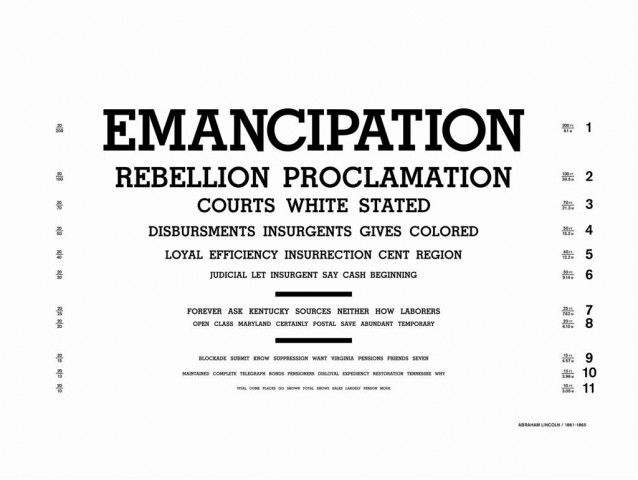GDB Looking Outwards – Max/MSP/Jitter
Hindsight is Always 20/20
Hindsight is always 20/20 is a review of all of the State of the Union Addresses based on frequency of words used in said address each year. As the name suggests, the piece serves as a forced historical re-evaluation of these presidents based, quite literally, on their choice of words.
I have to say that I am personally a fan of DuBois’ work. A few months back, I had the pleasure of walking into his exhibition at the Ringling Museum without prior knowledge of his body of work. Hindsight was being shown there. The piece is initially quite confusing: rows of large cards on the walls, reminiscent of something an optometrist might have hung on the far wall. You probably didn’t read the small plaque explaining what is going on, but these cards seems to be politically oriented. Then everything slides into place once you see the president’s names and dates in the corner.
DuBois has a strong grounding in the conversion of data into conceptually meaningful work, and this shines through in Hindsight. Also, the piece’s inherent dryness coupled with the seeming foolishness of the some of the choice words come together to give it a strange humour.
D.O.R.T.H.E. – Lasse Munk and Søren Andreasen
D.O.R.T.H.E. is a machine that converts written language into music. It consists of a number of heavily-modified machines, cobbled together into an input device (seen above) , and a number of smaller ‘instruments’ that the main body uses as the output from the writing.
This piece fascinates me. The idea of turning words into music in this way is strong itself, but the physical implementation of this idea, from the typewriter as input to some truly strange musical inventions, is what makes this outstanding.
It’s difficult to tell from the video, but it seems that the situation under which D.O.R.T.H.E. will function seem quite constrained. The player always seems to stage the music in terms of small phrases, and the creation of sound does not seem to be real-time, but instead the machine seems to have to wait until the writer is finished.
Z-Machines – Squarepusher & Rhizomatics
Z-Machines is a set of robotic musicians, designed to be able to play conventional instruments in ways that people cannot.
I’ve hear some of Squarepusher’s stuff, and I like both his solo body of work and the end result audio of Z-Machines, but for me this piece is ruined by the robots. The decision to constrain the machines to anthropomorphism makes them visually weaker (by riding straight into the uncanny valley), as well as hamstringing the machine’s potential to be something new. Instead it just emulates what has already come before, and attempts to directly compete with human bands for performance value, which seems like wasted effort to me.
Pedro Reyes work comes to mind of someone who took similar principles in a more interesting direction.


